
Roma Cast of Characters Campo dé Fiori Caffè San Pietro Colosseo Foro Romano Chiesa del Gesu Pantheon P. Navona S. Pietro Il Papa S. Eustachio S. Maria Trastevere Trastevere Bocca Verità Fontana di Trevi Museo Vaticani Villa Borghese Vittorie Mangia! Loose Ends Desktops
|
.
.
.
.
.
.
.
.
.
.
.
.
.
.
.
.
.
.
.
.
.
.
.
.
.
.
.
.
.
.
.
.
.
.
.
.
.
.
.
.
.
.
|
2000 Italia: Colosseo (Coliseum) (2)
When Devin asked me what my goals were for our Roman visit. Somewhat jokingly I said "to visit famous places and eat there". Well, he took me at my word. We ate across the street from the Coliseum at a very pleasant restaurant, where the spaghetti amatriciana was very good (and much better than I expected of a possible tourist joint). Here you see Rose, Devin, and Cicki; given Cicki's intense look I'm guessing Isaac was running around behind me.
 One of the things I would very much like to have seen is a reconstruction of part of the biodegradable parts of the Coliseum. Take a small percentage of the entire stadia, perhaps a pie slice shape starting at the center of the arena and moving out to include fifty feet of the outer edge, and reconstruct the floor, the vending areas, the seating, and the retractable canvas canopy. Do it in such a way that nothing underneath is damaged, but give us an overlay view of how things were.
One of the things I would very much like to have seen is a reconstruction of part of the biodegradable parts of the Coliseum. Take a small percentage of the entire stadia, perhaps a pie slice shape starting at the center of the arena and moving out to include fifty feet of the outer edge, and reconstruct the floor, the vending areas, the seating, and the retractable canvas canopy. Do it in such a way that nothing underneath is damaged, but give us an overlay view of how things were.
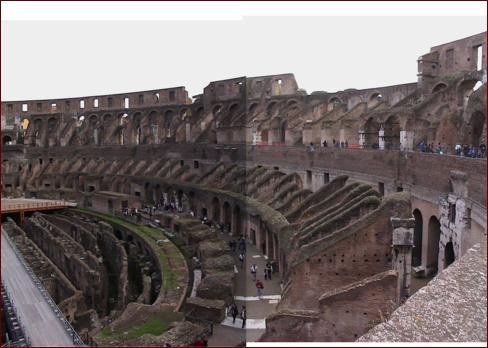
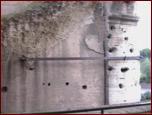
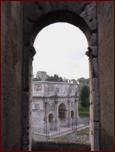 On my geek tour of the Coliseum I noticed these huge metal spanners (at left) holding together the structure of the upper floors. I doubt that these are originals; is there some Roman foundry which smelts replacement parts for those which have rusted away? What a mission statement such a place must have. Work for the ages.
At frequent intervals are archways which provide a view of the surroundings. During the working days of the Coliseum this would have included views of the nearby jails and holding facilities for the gladiators, none of whom relished the thought of several hundred fights before their contract was satisfied. (And many of those fighting weren't contracted; prisoners were just fodder for the entertainment empire. Since there was no limit on the number of lions which could be released through the many doors there wasn't a surfeit of survivors. The view you see at right is that of one of the celebratory arches. Just to the right of the arch, not visible in this picture, was a water fountain in which the victors could bathe after they exited the Coliseum. This fountain, more than two thousand years old, was destroyed by Il Duce, Mussolini, in the 1940s because it impeded his "victory parade".
On my geek tour of the Coliseum I noticed these huge metal spanners (at left) holding together the structure of the upper floors. I doubt that these are originals; is there some Roman foundry which smelts replacement parts for those which have rusted away? What a mission statement such a place must have. Work for the ages.
At frequent intervals are archways which provide a view of the surroundings. During the working days of the Coliseum this would have included views of the nearby jails and holding facilities for the gladiators, none of whom relished the thought of several hundred fights before their contract was satisfied. (And many of those fighting weren't contracted; prisoners were just fodder for the entertainment empire. Since there was no limit on the number of lions which could be released through the many doors there wasn't a surfeit of survivors. The view you see at right is that of one of the celebratory arches. Just to the right of the arch, not visible in this picture, was a water fountain in which the victors could bathe after they exited the Coliseum. This fountain, more than two thousand years old, was destroyed by Il Duce, Mussolini, in the 1940s because it impeded his "victory parade".
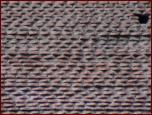
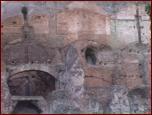 Heading south from the Coliseum one winds up on a walkway which runs through more ruins. What struck me was the impressions of the archways which had been attached to what remains; I wondered what had been there, in this vast site. A closer look at the outside walls of one of the buildings showed me the characteristic Roman brick, a thing slab.
Heading south from the Coliseum one winds up on a walkway which runs through more ruins. What struck me was the impressions of the archways which had been attached to what remains; I wondered what had been there, in this vast site. A closer look at the outside walls of one of the buildings showed me the characteristic Roman brick, a thing slab.
|
 subscribe
subscribe
 subscribe
subscribe